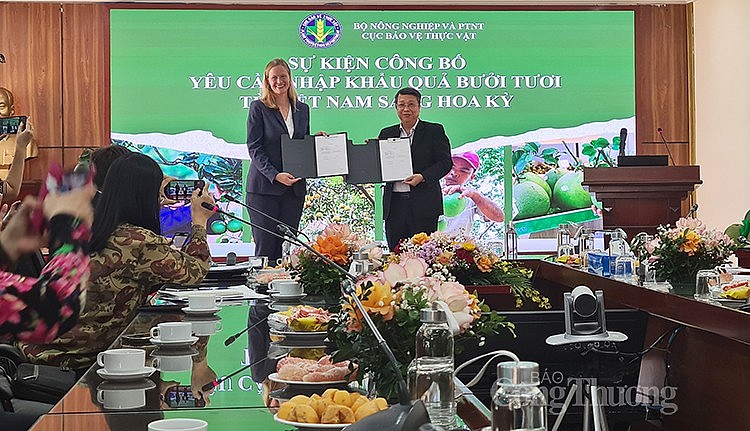 News
News
The event was held after the US Department of Agriculture (USDA) published in the Federal Register decided to allow the import of fresh Vietnamese pomelos into the US market from October 4, 2022.
 |
| The representative of the United States hands over the import request to the Plant Protection Department (Ministry of Agriculture and Rural Development) |
Thus, Vietnam's fresh pomelo (citrus maxima) is the 7th fruit of our country allowed to be imported into the United States, after mango, longan, litchi, dragon fruit, rambutan and breast milk. Besides, some other fruits such as coconut and durian are still exported to the US but in the form of frozen products.
According to US regulations, the growing area and processing facility of fresh Vietnamese pomelos exported to the US must be registered with the Plant Protection Department and the US Animal and Plant Quarantine (APHIS); the fruit must not be contaminated with a phytosanitary object of interest to the United States; treated with irradiation; and was granted a phytosanitary certificate by the Plant Protection Department.
Accordingly, pomelo growing areas and packing establishments must have appropriate management measures to eliminate the pests of your interest, including fruit flies Bactrocera dorsalis, Zeugodacus cucurbitae; the fruit borer Prays endocarpa and the fungi Cylindrocarpon lichenicola, Phyllosticta citriasiana.
Particular attention should be paid to the application of the following management measures for the fungi Cylindrocarpon lichenicola and Phyllosticta citriasiana: Remove all fallen fruit before entering the packhouse; Must be cleaned, treated with fungi and waxed the whole fruit; Remove all leaves, stalks and other plant parts (except for fruit stalks shorter than 2.5 cm that are still attached to the fruit).
In addition, shipments of fresh pomelos exported to the United States must be irradiated with a minimum dose of 150 Gy, accompanied by a Phytosanitary Certificate.
In order to implement the pomelo export program to the US, the Plant Protection Department will coordinate with related parties to synchronously deploy solutions, especially focusing on training for producers and exporters. pomelo on US import requirements; register and maintain export growing area codes according to TCCS 774:2020/ TCCS 775:2020 and conditions for importing pomelos into the United States; closely monitor pests (SVGH) and guide prevention at the planting area, ensuring to avoid re-infection of SVGH at the packing facility; irradiation treatment at US-accredited irradiation facilities under the supervision of APHIS and the Plant Protection Department for all export shipments to the United States.
The Plant Protection Department requires relevant parties to export fresh grapefruit to the United States to coordinate and fully comply with the requirements under the signed Export Program to ensure that grapefruit shipments from Vietnam are imported. into the United States.
There is no denying the potential of the US market with Vietnamese fruit. The United States has a large consumption demand for fruit, up to 12 million tons per year. The country's domestic fresh fruit production currently only meets 70% of the demand, the remaining 30% (equivalent to about 3.6 million tons) must be imported (according to USDA, 2021). Meanwhile, our whole country has 105,400 ha of pomelo growing, with an output of nearly 905 thousand tons; with diverse pomelo varieties, typical for each region.
Specifically, the Red River Delta has more than 13 thousand hectares with an output of over 175 thousand tons, the Northern Midlands and Mountains has more than 30,000 hectares with an output of 253 thousand tons. The Mekong Delta alone has about 32,000 hectares with an output of about 369 thousand tons (according to the Department of Crop Production, 2022). exclusively to access the US market.